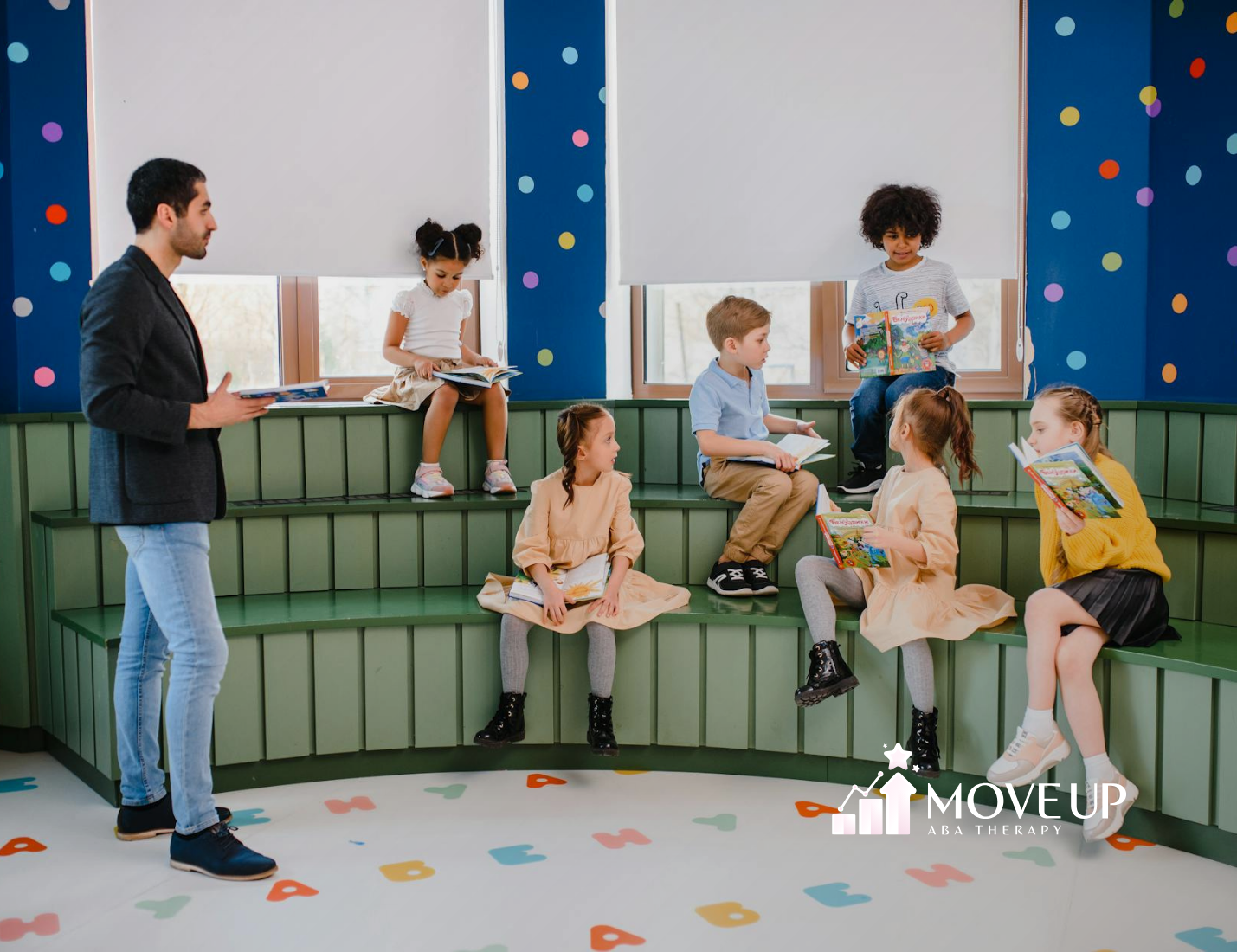Finding the right therapy for children on the autism spectrum can be hard. There is ABA therapy and VB therapy, and many people wonder which is best. Both of these come from behavior analysis, but there are some big differences. ABA therapy looks at a lot of things and aims to help in different areas. VB therapy focuses on building functional communication skills. This blog will talk about the main parts, the good things, and the differences between ABA therapy and VB therapy. It can help you choose what is right for your child’s unique needs.
Understanding ABA and VB Therapy
To see how ABA therapy and VB therapy are not the same, you have to know what each one does in behavior analysis. Applied Behavior Analysis, or ABA therapy, uses a wide plan that helps get desirable behaviors. The goal is for people to do better in all parts of life. This can include social interaction, learning skills, or self-care.
VB therapy, or Verbal Behavior therapy, is different from ABA in some ways. The main focus of VB therapy is on language development. It helps children learn why we use words and how to use them for meaningful communication. While VB therapy does use ABA principles, it is more focused and has a smaller range than general ABA. In the next section, we will take a deeper look at what is important for each of these therapies.
What Is ABA (Applied Behavior Analysis) Therapy?
ABA (Applied Behavior Analysis) therapy is a proven way to help people change certain actions. This therapy uses steps and rewards to help grow good behaviors and lessen actions that may not help. In behavior analysis, the focus is on what can be seen and measured. Applied behavior analysis works by using ideas like positive reinforcement. That means when someone does something wanted, they get a reward. This helps people with different needs learn better ways to act.
What Is VB (Verbal Behavior) Therapy?
VB (Verbal Behavior) therapy helps people learn to talk by looking at how they use words. This type of therapy works on helping people use language in real life. It helps them get better at speaking and improves how they connect with others. The therapy breaks big goals into smaller steps. These steps use the principles of behavior to make it easier to learn. Through this, people can build better verbal behavior and social interaction.
Core Principles Behind ABA and VB Approaches
Both ABA therapy and VB therapy are part of behavior analysis. These methods help people learn new skills and change their actions. ABA principles use different ways to make many behaviors better, while the verbal behavior approach mainly helps people with functional communication.
Both therapies use positive reinforcement. This means they reward good actions so people are more likely to do them again. While ABA therapy and VB therapy have the same base, they use their own methods. These distinct methods match different needs and goals as people grow. Now, let’s look at the special ways each one works.
Foundational Techniques in ABA
ABA techniques use clear instructions and small steps to help with skill development. This way, the learning process is easier to follow. Positive reinforcement is at the heart of ABA, as people get rewards for doing the right thing.
Discrete trial training, or DTT, is a focused way to teach important foundational skills. For example, DTT can help with skills like making eye contact or listening to a simple command. This method breaks down tasks, so a person learns bit by bit.
Another ABA technique is errorless learning. Here, trainers give prompts so the learner makes few mistakes. These prompts are pulled back slowly, helping the person build up new skills and confidence to do things on their own.
In natural environment teaching, skills are taught in everyday settings. So, someone may get to count objects while playing or learn how to act in social situations with friends. ABA makes sure the focus stays on building up all kinds of foundational skills for daily life.
Communication and Motivation in VB Therapy
VB therapy puts the focus on functional communication. The aim is to help kids get motivated to use language. In this method, children learn useful verbal skills. They learn how to ask for what they need, which are called mands, and how to name things, which are called tacts. This helps them find their way in the world around them. When they get the right answer, they get reinforced, so they use words in ways that matter.
Therapists use activities that are fun and based on what the child likes. For instance, when a child plays with a ball, the therapist may teach them to say “ball.” This gives the child a natural reason to talk. By focusing on meaningful communication, VB therapy helps a child interact with others and say what they want or need much better.
VB therapy also helps kids practice conversation skills, which are known as intraverbals, during their sessions. These skills help kids get ready for social times. Because VB therapy is all about verbal behavior, it can be good for children who do not talk yet or have trouble with speech. Let’s now take a look at the differences between ABA and VB therapy to decide which matches your child’s needs the best.
Key Differences Between ABA and VB Therapy
The main differences between ABA therapy and VB therapy are in what they focus on and what they want to achieve. ABA therapy works on a wide range of skills. This includes emotional regulation, social behavior, and getting tasks done. VB therapy puts most of its attention on language use and helps people build good, functional communication.
ABA therapy uses a plan that can help children with many different needs. VB therapy is better for children who have a hard time speaking or understanding spoken words. Some families may need both kinds of help. Using both types together can give the best support. Now, let’s look at what these therapies aim to do.
Focus Areas and Therapy Goals
| Focus Areas | ABA Therapy | VB Therapy |
|---|---|---|
| Behavioral Modification | Targets behaviors affecting learning, emotional regulation, and independence. | None, as VB focuses exclusively on communication. |
| Language Development | Included but not central, often uses VB techniques to support verbal skills. | Main focus, developing functional communication with verbal operants. |
| Social Interaction | Addresses interaction through games, role-play, and structured learning. | Tailored to conversational skills using intraverbals. |
| Individual Needs | Comprehensive programs covering a wide spectrum of developmental domains. | Focused but structured approaches for speech and communication delays. |
By analyzing the table, you can decide your child’s priority needs—whether they suit ABA programs or VB communication strategies. Next, we’ll dive into teaching techniques.
Methods of Teaching and Skill Development
Methods in both therapies use systematic techniques, but they are not the same. ABA uses reinforcement strategies with set ways like discrete trial training. In this, tasks get broken down into smaller parts. Kids repeat these steps until they master them. Learning also happens in real life. For this, ABA uses natural environment teaching.
VB therapy is different. It teaches verbal operants, like mands, by using games or situations where kids need to make real requests. These sessions help build meaningful interactions. The focus is on kids giving verbal responses that lead to real things happening.
Both therapies work towards skill development for each child’s needs. ABA looks at building basic skills in many areas. VB therapy helps fine-tune language acquisition. By working together, these approaches support a child’s growth. Now, let’s look into the benefits each one brings.
Benefits of ABA and VB Therapy for Children With Autism
Both ABA therapy and VB therapy are very helpful for children who have autism spectrum disorder. ABA is used to teach children important daily living skills and help with emotional regulation. It also helps to lower challenging behaviors.
VB is great for building communication abilities. It helps children with autism spectrum say what they need or feel. This can lower stress and make it easier to use language in daily life.
You can use both therapies together or each one by itself. No matter which way is used, they help create a supportive environment where a child can grow. Now, let’s look closer at how these therapies help children get better at communication and social skills.
Improvements in Communication, Social, and Daily Living Skills
Both therapies help children grow and learn new skills in different ways:
- Communication Skills: ABA helps with basic talking and listening. VB works on using words to ask for things they need.
- Social Integration: ABA uses role-play and group games to help children take part in activities with others. VB helps kids talk with each other by teaching how to answer and start conversations with intraverbals.
- Daily Living Skills: ABA helps children learn everyday tasks like getting dressed, eating, or keeping their things in order so they can be more independent.
- Desirable Behaviors: ABA uses positive reinforcement to help children show kindness, be patient, and adjust well in different places.
By using ABA and VB together, children get well-rounded support and skill building. These methods may help bring good results later in life.
Long-Term Outcomes and Family Impact
The effects of therapy reach well past the actual sessions. ABA helps the child get better at handling everyday tasks. This supports their independence and helps them feel sure of themselves in daily life. VB makes it easier for them to talk with people and form social bonds by improving how they interact with others.
Families get to be in a supportive environment. Here, they team up to help the child work on emotional regulation and different skills that are needed as the child grows. Positive reinforcement helps everyone—parents and therapists build trust, and children get ready for what comes as they get older.
When you keep at it, these therapies lead to a better quality of life. Children have the hope of a brighter future, and family bonds get stronger. Now, it is time to finish up by helping you make choices with the right information.
Conclusion
In the end, it is important to know the differences and the good things about ABA and VB therapy. This helps parents and other caregivers pick the right support for kids with autism. Each therapy has its way to help children grow their communication, social skills, and help with daily life. When you learn about the main ideas and methods behind each one, you can choose what is best for your child’s needs and what you want for them. You may pick ABA, VB therapy, or even use both together. Putting in time for these therapies can make a big, lasting change in your child’s life over the years. If you want to know more or get started, ask for a free consultation to find out what will work best for your child’s development.
Frequently Asked Questions
What is the main difference between ABA and VB therapy?
The main difference is where the focus is. ABA therapy works on a wide range of behaviors and skills. VB therapy, on the other hand, works mostly on functional communication by using verbal operants. Both ABA therapy and VB therapy are part of behavior analysis, but they each have their own role in how people grow and learn.
Can ABA and VB therapies be used together?
Yes, mixing ABA programs with VB therapy works well. Certified behavior analysts set up plans that fit individual needs. They use strong ABA techniques and add language development from VB therapy. This way, people get all-around help for skill development. Both approaches together can help someone grow and learn in the best way.
Which therapy is better for non-verbal children?
VB therapy is very good for non-verbal children. It helps them learn to use functional communication. They can use gestures or other ways like sign language to say what they need. By using ABA principles with VB therapy, you help build a strong base for language development. It also helps them grow their skills to share their thoughts and feelings.
How long does it take to see progress with each therapy?
Progress in ABA therapy and VB therapy is different for each child. It depends on the child’s needs. Most children start to see some changes after going to regular therapy sessions. New skills come up slowly, taking a few months. It is important to be patient and work together, as this helps get good results.
Are these therapies effective for all age groups?
Absolutely! Both ABA therapy and VB therapy help people in many age groups. They support those with many types of developmental disorders. The ways this help is given can change to fit each person’s needs, whether the goals are big or small. People can use these therapies to get better at a wide range of skills.
Sources:
https://trueprogresstherapy.com/blog/aba-therapy-vs-vb-therapy/
https://www.autismspeaks.org/applied-behavior-analysis
https://www.autismspeaks.org/verbal-behavior-therapy
https://gsep.pepperdine.edu/blog/posts/aba-techniques-strategies-for-behavior-analysts.htm
https://www.connectncareaba.com/blog/aba-therapy-vs-vb-therapy






